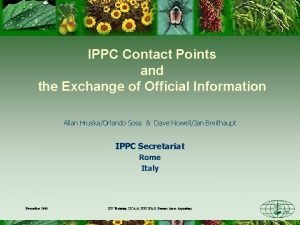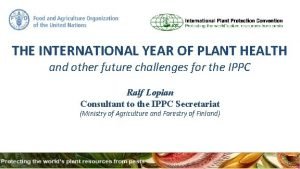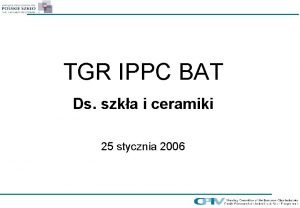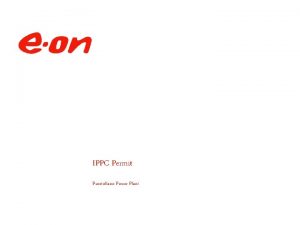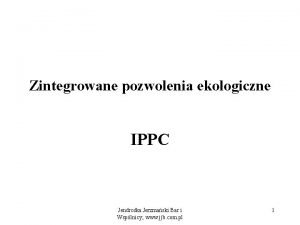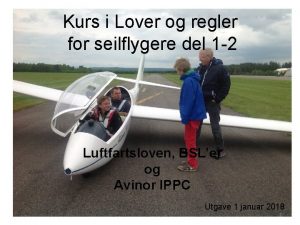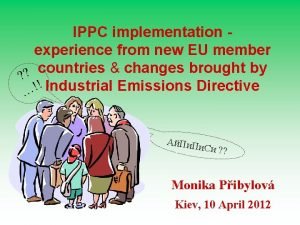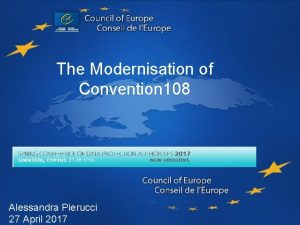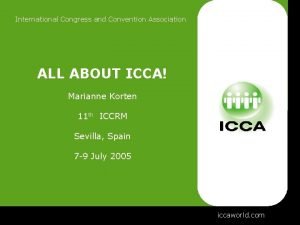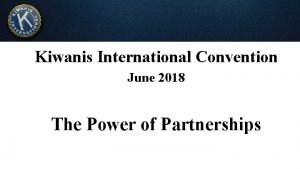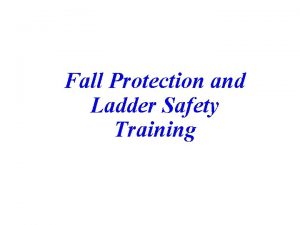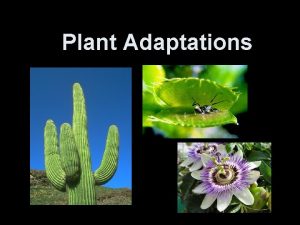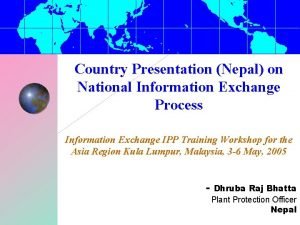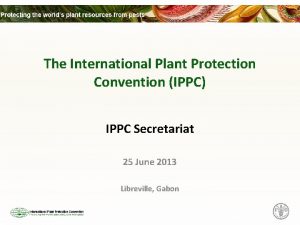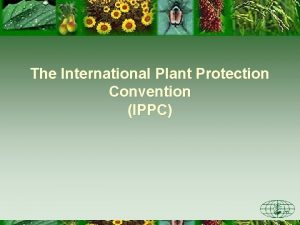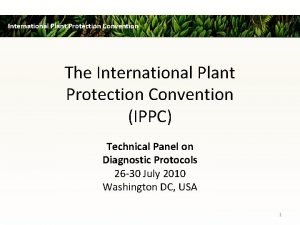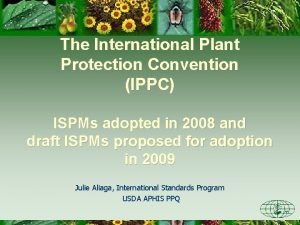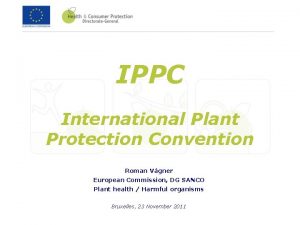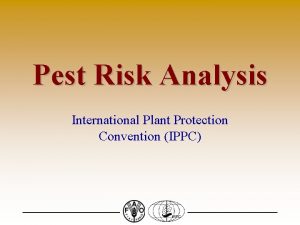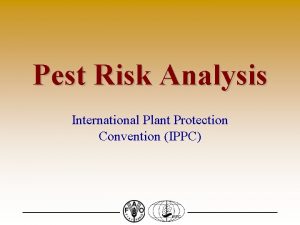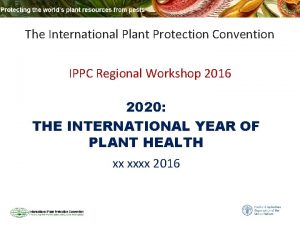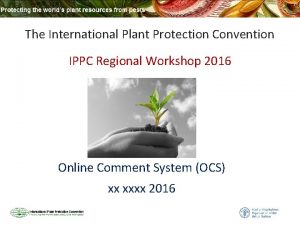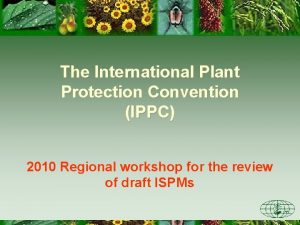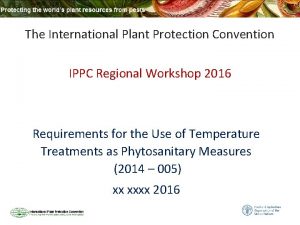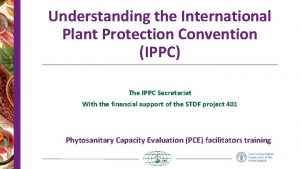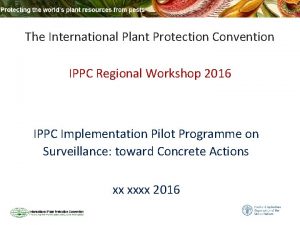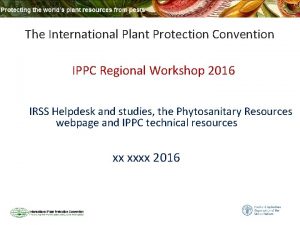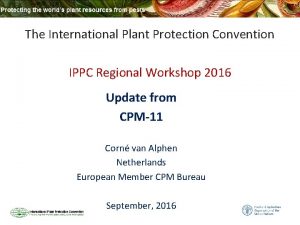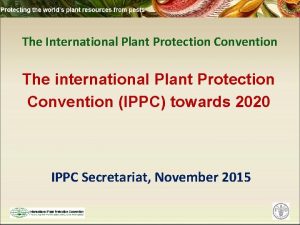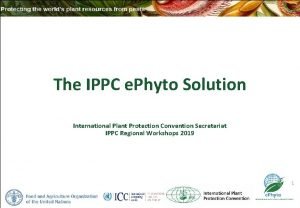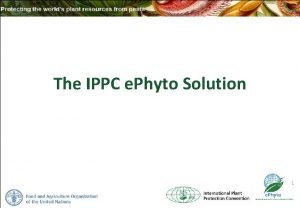The International Plant Protection Convention IPPC Outline of



































- Slides: 35

The International Plant Protection Convention (IPPC)

Outline of Presentation 1. The Convention (IPPC) 2. IPPC Standards and the SPS Agreement 3. IPPC administrative framework 4. Core activities – Standard setting process – Implementation and exchange of information – Technical Assistance

The IPPC Convention 173 NATIONS PROTECTING THE WORLD’S PLANTS AGAINST PESTS

The IPPC: What we do • International framework for protection of plants from pests • Standard setting organization • Facilitates exchange of information to support the mission of the IPPC

IPPC: History • Original IPPC adopted in 1951 • Revised in 1979 • Revised again in 1997 to be consistent with principles of the SPS agreement – formalizes Secretariat and standard-setting

IPPC and the WTO-SPS Agreement • IPPC is one of the “three sisters” of international standard setting recognized by the SPS agreement: Codex, OIE, IPPC • Members shall base their phytosanitary measures on international standards or justify deviations through risk analysis • Members shall play a full part in the relevant standard setting organization (Article 3 of the SPS Agreement, Harmonization)

The IPPC: Key principles • Sovereign right to regulate • Regulate only when necessary • Measures should be: – consistent with risk, technically justified, and least restrictive – non-discriminatory – transparent (published)

The IPPC: Key obligations • Set up and administer a National Plant Protection Organization (NPPO) • Designate an official IPPC contact point • Certify exports and regulate imports • Develop and take into account phytosanitary standards • Meet basic reporting obligations

Adherence to the IPPC Deposit instrument of adherence to the IPPC with the Director General of FAO. • Signed by the person responsible for signing international treaties on behalf of the government

IPPC Administrative Framework • CPM – Administrative bodies of the CPM • NPPO • RPPO • Secretariat

Commission on Phytosanitary Measures (CPM) • Governing body for the IPPC (173 member countries) • Adopts International Standards for Phytosanitary Measures (ISPMs) • Promotes technical assistance and information exchange • Meets annually • Provisional date and venue for the next meeting is: CPM-6 14 -18 March 2011 FAO headquarters, Rome, Italy

CPM administrative bodies • Bureau (7 members) • Standards Committee (25 members) • Subsidiary Body on Dispute Settlement • Informal Working Groups

IPPC Secretariat • Hosted by the Food and Agriculture Organization (FAO) in Rome, Italy • Implements the work programme • Supports the development of ISPMs • Facilitates information exchange • Provides input into technical assistance programmes • Facilitates dispute settlement • Represents the IPPC

National Plant Protection Organization -- NPPO Role: to protect national plant resources from the risks associated with pests – food security: protect crops to ensure an abundant, high-quality, and varied food supply – international trade: strengthen the marketability of agriculture in international commerce by meeting import requirements, including pest risk analysis – environmental protection: preserve natural ecosystems and horticultural plant resources

Regional Plant Protection Organization -- RPPO Role is to: • Coordinate and participate in activities among their NPPOs in order to promote and achieve the objectives of the IPPC • Gather and disseminate information, in particular in relation with the IPPC • Cooperate with the CPM and the IPPC Secretariat in developing and implementing international standards for phytosanitary measures and regional standards • Meet annually at the technical consultation among RPPOs

REGIONAL PLANT PROTECTION ORGANIZATIONS APPPC Asia and Pacific Plant Protection Commission CA Comunidad Andina COSAVE Comite de Sanidad Vegetal del Cono Sur CPPC Caribbean Plant Protection Commission EPPO European and Mediterranean Plant Protection Organization IAPSC Inter-African Phytosanitary Council NAPPO North American Plant Protection Organization OIRSA Organismo Internacional Regional de Sanidad Agropecuaria PPPO Pacific Plant Protection Organization

ISPMs International Standards for Phytosanitary Measures • Developed by Members • Adopted by the CPM • Implemented by Members

Standards committee (SC) • Group of 25 international experts from the 7 FAO regions • Meets two times annually (May, November) • Oversees the standard setting process – Approves specifications for ISPMs, approves draft ISPMs for member consultation, reviews member comments, recommends ISPMs for adoption by the CPM – Oversees work of EWGs and TPs

Expert Working Groups • EWGs draft ISPMs for SC review • NPPOs and RPPOs nominate subject matter experts • Qualified experts are selected by SC • EWGs usually meet only once • Work is guided by steward for ISPM

Technical panels (TPs) • Five technical panels with specialized expertise meet to draft ISPMs and diagnostic protocols, approve treatments, and review the glossary of phytosanitary terms • Term of membership is five years • The Secretariat calls for experts for panels on asneeded basis. • NPPOs and RPPOs nominate experts • SC oversees work of technical panels

Standard setting Work programme • 34 adopted ISPMs (not counting ISPMs adopted at CPM-5 (2010) • 75 topics at various stages of development on the work programme

Steps in the Standard Setting Process • • New topics added to the workplan Standards Drafted Member Consultation Adoption of Standards by CPM

Standard setting process: New Topics • Call for topics is made once every two years • Topics and priorities agreed by the CPM are added to the workprogramme Next call for topics: 01 June - 31 July 2011

Standard setting process: Drafting standards • Standards are drafted by experts with opportunities for all contracting parties to provide input • A specification is developed to clarify the scope of the standard • Experts are nominated by NPPOs and RPPOs to draft standards • Experts meet to draft standards • Draft standards are reviewed by the Standards Committee • Draft specifications are sent to NPPOs and RPPOs for member consultation

Standard setting process: Member Consultation • Draft ISPMs are sent for a 100 day comment period • Draft ISPMs are discussed at regional workshops. • Countries discuss issues and prepare comments to use as a basis for their national comments. • Countries must submit national comments through considered by the Standards Committee in redrafting the standards. their NPPO contact point in order for them to be • Member comments are incorporated into ISPM by steward. • The revised ISPM is by reviewed SC, and may be recommended for adoption by CPM

Standards for Member Consultation 21 June – 30 September 2010 • Systems approaches for pest risk management of fruit flies (Tephritidae) • Submission of new treatments for inclusion in ISPM No. 15 • Integrated measures approach for managing pest risks associated with international trade of plants for planting • Irradiation treatment Ceratitis Capitata (Annex ISPM 28) • Diagnostic protocol for Plum pox virus (Annex to ISPM 27)

Member Consultation 2010 • Once again, member countries have volunteered to assist Secretariat to compile comments • Online system for compiling comments should be functional for member comment period 2011

Standard Setting Process: Draft ISPMs sent to CPM for adoption • Draft ISPMs sent to CPM for adoption are posted on the IPP before CPM • Member comments are accepted until 14 days before CPM

Draft ISPMs adopted by CPM-5 (2010) • Pest free potato (Solanum spp. ) micropropagative material and minitubers for international trade. • Design and operation of post-entry quarantine stations for plants. • Annexes to ISPM No. 28 (Phytosanitary treatments for regulated pests) – Irradiation treatment for Conotrachelus nenuphar – Irradiation treatment for Grapholita molesta under hypoxia. • Annex to ISPM No. 27 (Diagnostic protocols for regulated pests) – Diagnostic protocol for Thrips palmi Karny • An amendment to ISPM No. 5 (Glossary of phytosanitary terms).

Information Exchange

Dispute Settlement • Subsidiary Body on Dispute Settlement activities include: – Development of dispute settlement procedures – Maintenance of roster of phytosanitary experts – Provision of information for the effective preparation of a dispute settlement • Group of 7 international experts from the 7 FAO regions

Capacity Development • IPPC staff provide phytosanitary support to: – FAO technical cooperation programmes (TCPs) – Ad hoc workshops (e. g. WTO, SPS) – Programmes of other regional and international organizations (e. g. IAEA, STDF)

How to participate in the IPPC? • Suggest relevant topics for ISPMS – IPPC call for topics biennial • Draft ISPMs – nominate experts for expert working groups and technical panels • Review and comment on IPSMs – Participate in regional workshops – Comment on standards during member consultation • Attend CPM – Participate in evening sessions on ISPMs • Consider new strategies and business plan

Calls for member input • 30 November 2010: Call for experts - Technical panel on diagnostic protocols, Bacteriologist • 30 October 2010 (Due date extended): Call for experts for the Technical Panel for the Glossary (Russian and Spanish languages) and EWG on Minimizing pest movement by sea containers and conveyances in international trade • 30 September: Member comments on draft ISPMs

Contact International Plant Protection Convention Secretariat Food and Agriculture Organization of the United Nations Viale delle Terme di Caracalla 00153 Rome, Italy Tel: (+39) 06 5705 4812 Fax: (+39) 06 5705 4819 E-mail: ippc@fao. org Website: www. ippc. int
 Ippc contact point
Ippc contact point Ippc
Ippc Ippc bat
Ippc bat Ippc permit
Ippc permit Ippc bat
Ippc bat Avinor ippc
Avinor ippc Ippc countries
Ippc countries Danube river protection convention
Danube river protection convention Convention 108 data protection
Convention 108 data protection International congress and convention association
International congress and convention association Kiwanis international convention 2019
Kiwanis international convention 2019 Fall protection training outline
Fall protection training outline Structural adaptation for plants
Structural adaptation for plants Plant protection directorate nepal
Plant protection directorate nepal International foundation for protection officers
International foundation for protection officers Paragraph sandwich example
Paragraph sandwich example Plant cell outline
Plant cell outline Objective of plant breeding
Objective of plant breeding Plant breeding for disease resistance
Plant breeding for disease resistance Plant introduction in plant breeding
Plant introduction in plant breeding Tronsmo plant pathology and plant diseases download
Tronsmo plant pathology and plant diseases download Tronsmo plant pathology and plant diseases download
Tronsmo plant pathology and plant diseases download Albugo eye
Albugo eye International business transactions outline
International business transactions outline Hình ảnh bộ gõ cơ thể búng tay
Hình ảnh bộ gõ cơ thể búng tay Ng-html
Ng-html Bổ thể
Bổ thể Tỉ lệ cơ thể trẻ em
Tỉ lệ cơ thể trẻ em Voi kéo gỗ như thế nào
Voi kéo gỗ như thế nào Chụp phim tư thế worms-breton
Chụp phim tư thế worms-breton Chúa yêu trần thế
Chúa yêu trần thế Môn thể thao bắt đầu bằng chữ đua
Môn thể thao bắt đầu bằng chữ đua Thế nào là hệ số cao nhất
Thế nào là hệ số cao nhất Các châu lục và đại dương trên thế giới
Các châu lục và đại dương trên thế giới Công của trọng lực
Công của trọng lực Trời xanh đây là của chúng ta thể thơ
Trời xanh đây là của chúng ta thể thơ
